Because of its simple structure and strong adaptability, hammer mill is widely used in feed processing industry. Grinding technology is the important link of improving feed quality in the process of feed production, which can make full and reasonable use of feed. The particle size of feed is very important. The following analysis from three aspects of feed grinding particle size on the impact of feed quality.

First, Affect the utilization rate
Feed grinding particle size affects utilization ratio. Grain raw materials, such as corn, wheat, soybean, its seed coat is very hard, if directly feeding livestock, its digestive juice is difficult to infiltrate. After crushing, the seed coat of the grain is torn and the internal nutrients are exposed, which makes the contact area of the feed larger and more conducive to the infiltration of the digestive fluid of livestock and poultry, thus improving the digestibility and absorption rate of livestock and poultry.
Second, the influence of mixing uniformity
Feed grinding particle size directly affects the mixing uniformity. According to the experiment, the smaller the average mixed particle size is, the more uniform the particle size is, and the higher the mixing uniformity is, it is not easy to produce the classification phenomenon in the later transportation and storage. Therefore, from the mixing process, in order to achieve a good mixing effect and to produce high-quality feed, it is necessary to ensure that all raw materials of smaller and similar particle size.
Third. Affect granulation process and pellet quality
Finally, the particle size of grinded material also affects the granulation process and pellet quality. The same material, if the particle size and particle composition is different, the final granulated pellets quality is different. The finer the grain feed is crushed, the more the starch granules are gelatinized and the more uniform the moisture content is after steam conditioning. At the same time, the abrasion of the ring die can be reduced, the granulating feed pellets is more compact, and the pulverization rate is greatly reduced. However, it is also necessary to avoid the increase of power consumption, the decrease of output and the arching of materials due to the too fineness crushing.
Cooler is widely used in the cooling section of feed production, which has a significant impact on the quality of particles. It is an indispensable equipment for processing feed, such as pellet feed, extruded feed and tablet feed.
Counter-flow cooler is mainly composed of closed air feeder, distributor, loading and unloading level device, cooling chamber, motor, discharging mechanism and so on. The discharging structure is the key structure, which is roughly divided into slide valve type, fence type, pendulum type, impeller type, vibration type and so on.
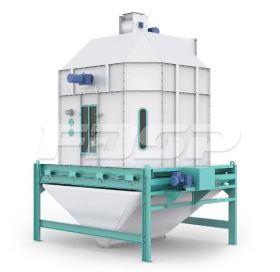
Working principle of cooler: At the time of counter-flow cooler working, the discharge direction is opposite to the direction of cold wind, so it is called counter-flow. After the pelleting section, the temperature and moisture are high and inconvenient to store. The pellet passes through the closed air feeder into the cooling box from top to bottom, piles up to a certain height is to trigger the high level indicator, and the motor is connected, discharge mechanism discharges through the principle of left and right reciprocating movement. Cold air flows from the bottom of the box to the bottom, and contacts with high temperature and high humidity materials for heat exchange, so as to achieve the effect of cooling materials and reducing water. This cooling method avoids the phenomenon of sudden cooling cracking caused by direct contact between cold air and hot material and effectively guarantees the quality of particles.
What are the common failures?
1.The failures of discharge institute (1) No discharge: check whether the loading level device is faulty; Check the motor or circuit has no fault; (2) Discharge without stopping: check whether the discharging level device is faulty; (3) Discharge frame movement is not sensitive, accompanied by noise: check the discharge composition structure has no fault, such as bearing, roller, guide rail is damaged, the friction resistance between discharge frame and flow regulation frame is too large.
| the solution: clean up the dust level device to avoid influence triggered effect, if the damage should be timely replacement, check the motor and the circuit of maintenance; Timely replacement of damaged parts: bearing, roller, guide rail, adjust the gap between the two frames.
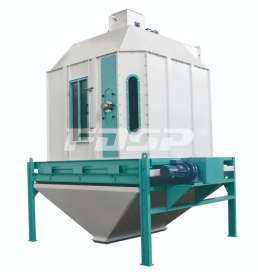
2.Material temperature is not up to standard (1)Uneven material temperature: uneven discharge mechanism installation or gap caused by uneven discharge; Uneven dividing plate; (2) High material temperature: the discharge amount is too large or the height of the material layer is low, will lead to the cooling time is too short, affecting the cooling effect; The cold air displacement is too small to cool the material sufficiently.
| solution: check and adjust the plate position, adjust the gap; Adjust the height of material level device, increase the stop time; Increase intake air volume.
3, The material water is high The air volume is too large and the cooling time is too short, will lead to the grain water can not be fully excluded, resulting in high water.
| The solution: down into the air volume, appropriate increase the cooling time, to the air flow, cooling time and moisture balance.
4. Material leakage during shutdown: When the discharge speed is too fast, due to inertia, it leads to material leakage; Stop the material level is wrong, the size of the gap of the discharging frame is uneven, resulting in the leakage of material.
| the solution: Adjust the discharging rate, makes the downtime can be appropriate buffer. Adjust the position of the stop placer and the clearance of the discharge frame.
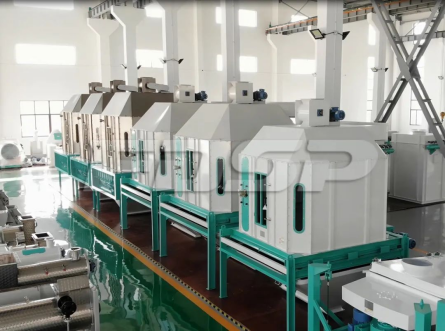
Counter-flow cooler should avoid high material level and quick discharge as far as possible, and should use discharge slightly larger than the amount of feed, which is conducive to the cooling of materials and the operation of equipment.
FDSP SKLN series counter-flow type cooler is mainly used for pellet feed cooling in the feed pelleting section, so that the temperature of high temperature particles cooling to no higher than room temperature 3℃-5℃, and can be reduced to safe water, after cooling the particles not only increases the hardness, but also can prevent mildew, convenient for the transportation and storage of pellet feed. The equipment uses counter-flow cooling principle to cool the high temperature and high humidity particles. At the same time, because of the use of closed air feed, and the inlet area is large, so the cooling effect is remarkable. The discharge is controlled by brake motor, which can stop instantly. The distributor, the adjustable level distributor and the turbine distributor have obtained 3 utility model patents.
Industrial dryer is widely used in food, feed, chemical, mining and other industries. When the equipment is working, the heating system starts and the material fully contacts the hot air through movement in the body to achieve preheating, drying, cooling and other processes, so that it reaches the preset drying degree. Commonly used drying principles are countercurrent, downflow, hot air circulation reflux and other ways. Because it belongs to large machinery, so the failure in use will greatly affect the work efficiency.
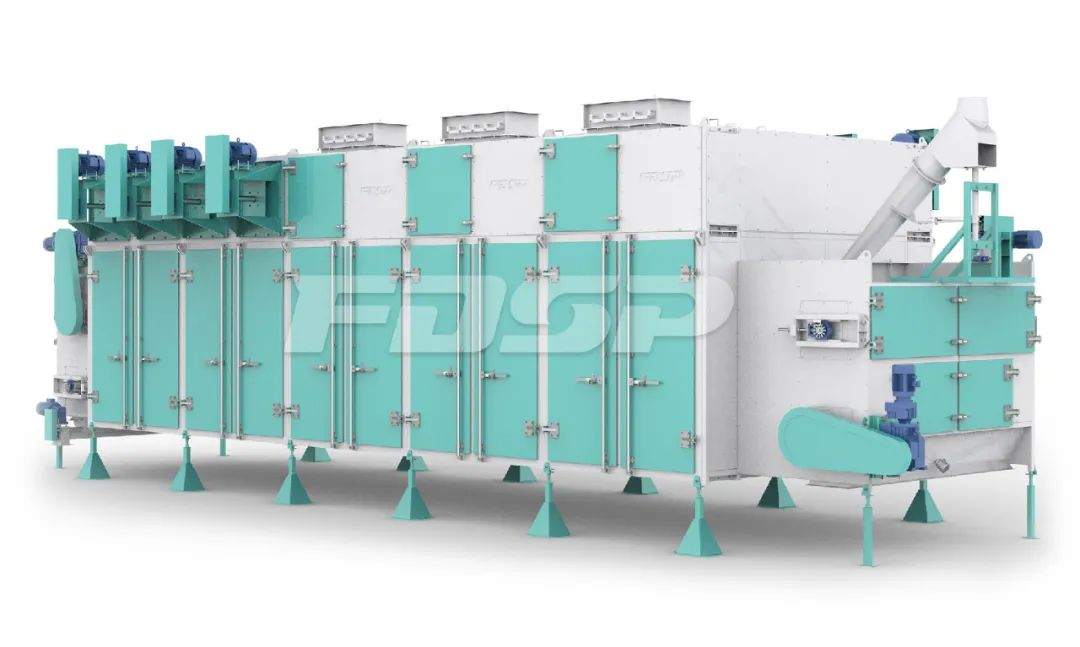
FDSP shares SHGW series horizontal circulation dryer
1.What are the common failures?
1.The moisture of the dried material is not up to standard
(1) The water is too wet or too dry
It is usually caused by improper supply of materials, improper specifications and use of dryer, and incorrect calculation of air pressure and flow rate of air network.
(2) Uneven humidity
Improper use of drying equipment, the material in the machine is affected by low temperature into a group, resulting in uneven contact with the hot medium, resulting in uneven dry and wet.
| the solution:
First check whether the amount of material and heat supply are balanced. By adjusting the amount of material input and heat supply dryer, to reach the humidity in the work. Check whether the use of dryer is correct and the selection of specifications is reasonable. Re-check whether the air pressure and flow rate of the air network meet the actual production demand. If there is a clumping of raw materials, it needs to be broken up again, and then sent into the machine for drying.

FDSP shares SHGW series horizontal circulation dryer
2. Finished materials cannot be discharged normally
Improper installation of dryer, air leakage, resulting in insufficient wind pressure, resulting in dry finished materials can not be discharged normally.
| the solution:
Check whether the installation is correct according to the drawings. Check whether there is air leakage at the pipe interface, and adjust it in time.
3. There was an explosion in the dryer
(1) When the material input is too large or there are hard impurities, which is easy to clog, so that the movement path of the material in the body changes, and the collision friction with the housing;
(2) When the material quantity exceeds the preset heat of the drying equipment, the material is easy to catch fire due to overheating. Improper installation of equipment leakage, so that the wind pressure is not enough, materials can not be sucked away, accumulation of excessive overheating logistics lead to fire.
| the solution:
When the material is blocked, it should be stopped immediately for cleaning and timely be adjusted the logistics throughput. When the temperature of the dryer is too high, we should reduce the fuel supply, so as to reduce the temperature of the equipment. Check whether the specifications of the dryer meet the production needs, replace the large drying equipment. Timely check and adjust the dryer installation problems, whether there is insufficient air leakage flow and other problems.
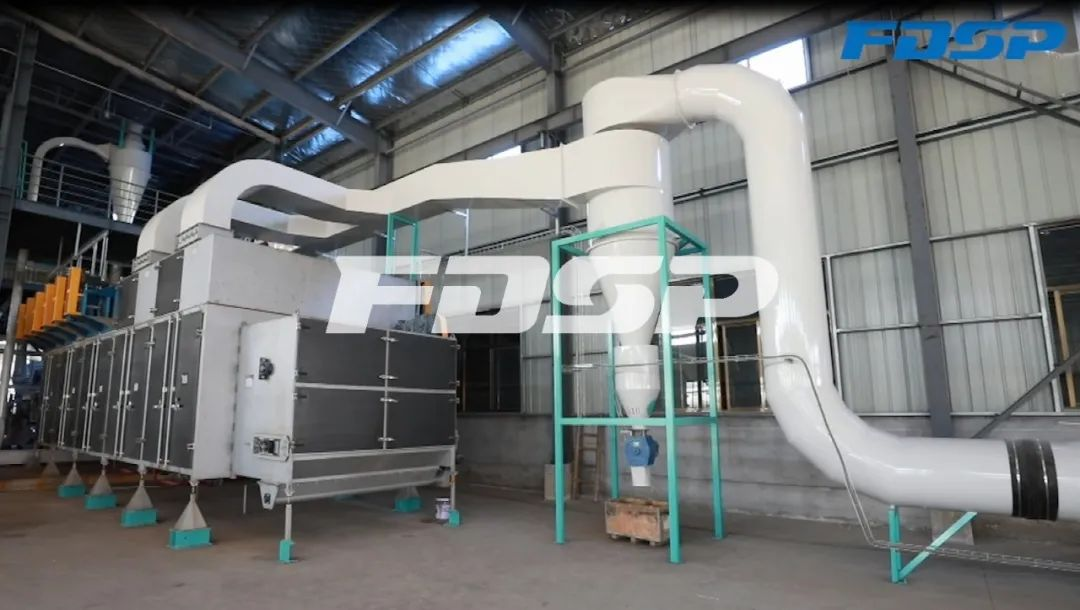
FDSP SHGW series horizontal circulation dryer is suitable for extruded feed drying in the feed industry, and is also suitable for feed, food and chemical industry powder, flake, strip and other materials drying treatment. The drying hot air in drying section uses left and right different directions, up and down convection circulation mode, so the material particle dry evenly, with the moisture error rate within 2%. Dryer heat exchanger is allocated with high efficiency trap, effectively removing the air and condensate in the steam pipe, steam pipe (air, condensate) after removal. The heat exchange function can be improved by 10%; According to user requirements, automatic temperature control device can be selected. Microcomputer PID automatic temperature control system is used for drying temperature control, with proportional pneumatic control valve, accurate temperature control error within 3℃.
Screw conveyor commonly known as "skein dragon", is a kind of non-flexible traction parts of the transport equipment, mainly made of motor, reducer, coupling, bearing, shell, screw shaft, inlet and outlet, etc.,It uses the motor to drive the spiral shaft rotation, shaft rotating spiral blade to promote the material along the tail of the shell conveying, can achieve horizontal, vertical and inclined transport. At present, it is widely used in mineral, feed, grain and oil, construction and other fields.
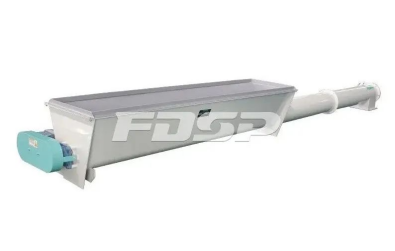
TLSS closed air screw conveyor
What are the common failures?
1.The staring difficulty: The main reason for the difficulty in starting the screw conveyor are abnormal reducer, small motor power selection and material blocking at the hanging bearing. The total driving power of the motor should be considered: the weight, length and lifting height of the conveying material. All kinds of resistance needed to be overcome in the work and friction resistance between material, shell and spiral blade. For a longer screw conveyor, it is also necessary to consider the resistance of the middle hanging plain bearing.
|The solution: Firstly screening reducer anomalies, timely repair or replacement. Secondly, check whether the rated power selection of the motor meets the actual production. When checking the power calculation, the material characteristics, the total resistance of transmission should be considered, and the appropriate safety factor is chosen.
2.Shaft end, flange joint and cleaning door channeling powder: Usually shaft end leakage powder is mainly due to the failure of the sealing structure: 1, The design of the sealing structure is not reasonable, resulting in material conveying shaft end connection is not tight dislocation structure; 2. The sealing parts are damaged, and the sealing strip at the joint of the flange is improperly selected or worn for a long time.
| Solution: To adjust the structure of shaft end seal design again. There are felt seal, rotating lip seals and packing seal and the combination of a variety of forms of seal, etc. for common used seal structure. When design, you need to fully consider the material characteristics, well balanced structure function and cost. The sealing strips at flange joints and cleaning doors should be checked and replaced in time.
3. Hanging bearing plugged: 1.Because the diameter of the hanging bearing is thick, and it is usually equipped with a support, the cross-sectional area of the material is small, It leads to the plugging of the material. 2. The blade out of the hanging bearing is disconnected, and the material can only be pushed by the front material when it passes through.
| The solution: Under the condition of material quality request is not high, for a small conveyor, as far as possible to avoid using hanging bearing. It can use bold tube shaft structure design; If the conveying distance is too long, the hanging bearing has to be used. In the structural design, the width of the hanging bearing should be as small as possible, and the cross-sectional area of the material should be increased as far as possible.
4. Pipe shaft fracture: 1.When large and hard foreign bodies are entered into the conveyor, the pipe shaft will be broken during operation; 2. During machining, the clearance between shaft head and tube shaft is too large, and the torque is mainly transferred by bolts during rotating transportation. Long-term operation leads to fatigue cracking of bolts.
| The solution: Strengthen check the fit tolerance between the tube shaft and shaft head is in line with the requirements in production process. Check whether there are foreign bodies in the body and materials before starting and conveying. Clean and debug in time.
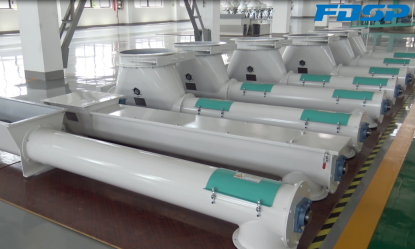
TLSS series closed air screw conveyor is suitable for grain, feed and other granular or powdered horizontal transportation. It is mainly used for short distance transportation. Shaft end double sealing structure effectively prevents leakage. The material sealing device can be added at the discharge end, and the bearing seat at the outlet end adopts a simple dust isolation structure, which is safe and reliable. The discharging end is equipped with a cleaning operation door. Cold drawing formed blade is adopted, more uniform pitch, more wear-resistant blade. It is suitable for horizontal or inclined conveying.
When the belt bucket elevator starts to run, the hopper scoops up the material from the bottom storage, and with the conveyor belt lifted to the top, it turns down after bypassing the jacking wheel, and puts the material into the receiving slot. Belt drive bucket elevator transmission belt generally adopts rubber belt, installed on the transmission drum and reversing drum.
Elevator in the production process often appear belt deviation phenomenon, resulting in hopper filled material is not sufficient, discharge is not complete, produce back material increase phenomenon, affect productivity, serious will lead to belt card, tear, shorten the service life of the belt.
The following is the causes and adjustment methods of bucket elevator belt deviation:
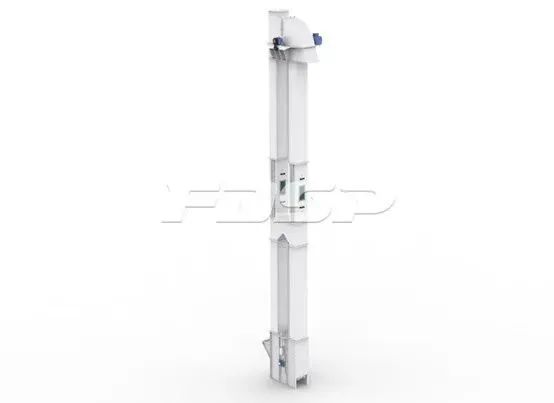
TDTG Series Bucket Elevator
1. The first wheel and the bottom wheel drive shaft installation is not correct
In simple terms, the position of the two transmission shafts of the bottom wheel of the bucket elevator should be in the same vertical plane, keep horizontal and parallel to each other, which can make the belt transmission rate to achieve the best. When the two transmission shaft installation is not correct, resulting in the distortion of the belt, uneven force, running belt deviation, hopper and fuselage impact, belt tear. From the mechanical analysis, there are usually the following 3 situations:
(1) The two transmission shafts are in the same vertical plane, but not parallel;
(2) Both transmission shafts are horizontal, but not in the same vertical plane;
(3) The two transmission shafts are parallel and in the same vertical plane, but neither shaft is horizontal.
Solution:
Stop the machine immediately, check the installation position of the head wheel and the bottom wheel, and readjust it to the upright position. It is necessary to pay attention to the double consideration and balance of allowable deviation and cumulative deviation.
2. Roller and surface of head wheel and tail wheel wear
Due to a long time of operation, the belt and the middle part of the drum for a long time friction, resulting in the middle of the rolling surface concave, both sides of the bulge phenomenon, resulting in the belt running left and right, because the drum is sealed in the fuselage and is blocked by the belt, it is not easy to be found, adjustment is difficult.
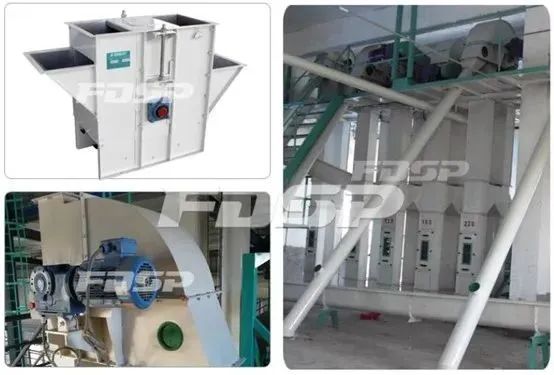
TDTG series bucket elevator
Solution:
The first wheel will remove the rubber paint on the surface of the drum after the rubber plating, it should be noted that the rubber plating surface is best to form the middle high on both sides of the low waist drum surface; After grinding, the tail wheel is similar to the head wheel. Control the height difference between the middle and both sides, and under the premise of ensuring the deformation range of the belt, the centripetal force is higher toward the middle of the roller, so as to avoid the deviation phenomenon.
3. Belt joint is wrong
Improper operation of belt in replacement installation will lead to joint deflection, at this time, both sides of the belt edge tight side loose, running belt to tight side, serious will cause belt card, tear
Solution:
Stop the machine to replace and debug the belt, check the alignment of the belt joint, and then do the joint filling treatment.
TDTG series bucket elevator is suitable for continuous vertical lifting of powdery, granular and small block materials. It can be widely used in feed mills of various scales, grain and oil, food, chemical industry, building materials, grain depot, port and wharf bulk materials. The head wheel is covered with glue to enhance the traction. Tail wheel’s special design, can effectively prevent deviation and skid; Multiple sealing, prevent material leakage, explosion-proof port, effectively prevent dust explosion. The equipment is equipped with a check device to avoid the problem of machine blocking caused by power failure; Speed measuring device and deviation alarm device can be selected according to user requirements to ensure safe and normal production.
In the work of linear vibrating screener, material deviation is a very common phenomenon, to solve the problem of deviation, can greatly improve the screening efficiency.
working principle of vibration screener:
Vibration screen mainly consists of screen, screening case, vibrator and driving system. During the running, the vibrating motor gives the exciting force, and the material go into the screener from the inlet is thrown up on the screen , at the same time, the screen and the material form a relative linear movement, the material by gravity falling through the multi-layer screen and screened out.
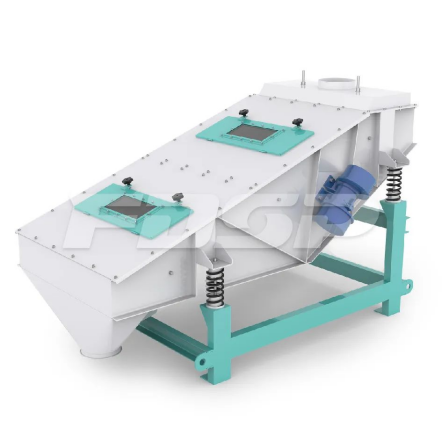
FDSP SFJZ series vibration screener
What will makes material deviation?
1. The vibration motor is not assembled correctly, and the angle between the two groups of eccentric blocks is not consistent
In general, the vibrating screen excitation source consists of two or more motors of the same type in series. The eccentric blocks installed at both ends of the output shaft produce centrifugal force at high speed to obtain the excitation force. When the angle between the eccentric blocks of the two groups of vibrators is different, the exciting force and direction of the series motor will change, resulting in torsional vibration of the vibrating screen, materials will appear deviation, rotation and retention, and other phenomena, affecting the screening efficiency.
Adjustment method:
1. Check the level of the screen, check and adjust the installation angle of the vibrating motor;
2. Check and adjust the eccentric block to make its direction and angle consistent;
3, Check whether there is damage to the vibration exciter bearing, pay attention to make cleaning, lubrication, sealing measures in place when disassembling.
2. over-work of the equipment and the running time is too long
The repeated vibration and strong inertia of vibrating screen during long-term operation make the equipment fatigue, especially the large machine body, parts will be loose, and the angle of motor easy to change, which leads to material deviation.
Adjustment:
Periodically to stop screener and make repair.
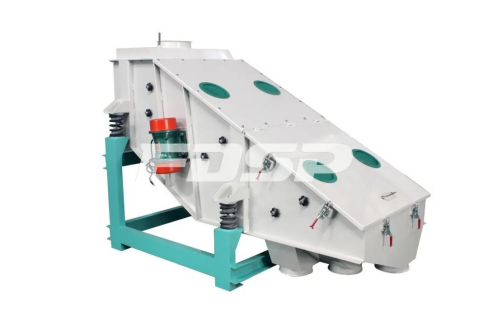
FDSP SFJZ series vibration screener
3. Uneven feeding results in eccentric loading
Feeding more and less, the force on the screen surface, throwing force, vibration force will produce deviation, resulting in a side of the discharge, affecting the stability of the screening accuracy.
Adjustment:
Check the abnormal situation of feeding inlet, such as clogging, leakage, stuck and other problems, timely adjustment and maintenance of the relevant parts, to ensure evenly feeding.
4. Screen frame are out of shape
When the vibrating screen is in normal operation, the force on the screen frame mainly comes from the load-bearing force of the material and the strong exciting force of the vibrating motor, If the sieve plate screen frame is not tight or the screen has damaged , it will cause second-time body vibration, screen box will be out of shape and damaged when seriously , finally leads to material mixed and deviation.
Adjustment:
1. Replace the damaged screen or sieve plate, strain the screen or sieve plate, eliminate the relative movement between the screen frame and the sieve body, avoid secondary vibration;
2. Check the screen box for damage, repair or replace it. Choose high-quality materials with high strength when purchasing sieves.
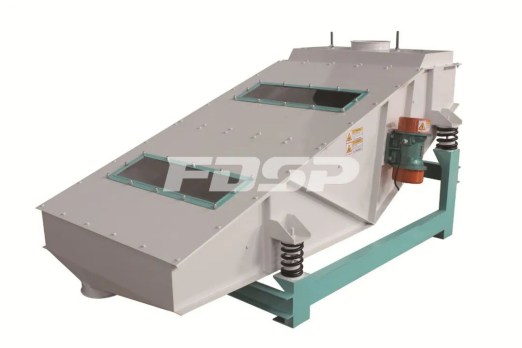
5. Damping springs are damaged or vary in stiffness
The damping spring installed under the screen box of vibrating screen is as important as the vibration motor. It plays an important role in maintaining the stability of vibrating screen and prolonging its life. When the spring with different stiffness is used, the natural vibration frequency of the spring is different, which affects the amplitude stability of the screen. Damping spring is divided into rubber, spiral steel spring and composite spring. For spiral steel spring, shock absorption spring coarseness is different, its strength is also different. If the vibrating screen is large or the exciting force of the vibrating motor is too strong, the use of a smaller damping spring may lead to the spring fracture, thus affecting the normal operation of the vibrating screen, resulting in material deviation.
Adjustment:
Check the spring damage and replace new one to ensure the same strength
FDSP SFJZ series vibrating screener is suitable for the later stage of pelletizing section in small and medium-sized feed factories. It can extract qualified pellet feed products by sieving the particles after pelletizing or crumbling, sift out the unqualified powder. The discharge port of the grading screen has a streamlined design, which avoids cross-contamination without material deposition, avoids oil leakage without oil lubrication, has a simple and convenient screen pressing mechanism, and can change the screen quickly. The driving mode adopts a self-balancing vibration mode, good screening effect, small size, smooth movement.
The grid screen is the simplest cleaning equipment. The main function is to prevent large impurities such as mud, stones and ropes from entering the material discharge hole, preventing blockage of the discharge hole and the later conveying and other processing equipment; it also prevents the feeding personnel from falling into the material feeding inlet to protect personnel safety. The grid screen is the first cleaning equipment, and almost every feeding inlet should be set up, such as in the main and auxiliary material feeding inlet of the main workshop, and the manual adding inlet of the additive next to the batching scale, etc. The gap of the grid screen should be determined according to different discharge ports and different materials. For example, the gap between the grids in the feed main workshop for corn and powdery auxiliary materials is about 30 mm. In the corn feed port in front of the vertical storage silo, because of the large output required, the gap between the grids can be larger. For the cake materials, due to its poor scattering, the gap between the grids should be about 40 mm. The grid screen should be fixed at the feeding port and ensure an inclination angle of 8 to 10 degrees, so as to pour out the material in the bag and reduce the labor intensity of the feeding. The cleaner is the main equipment for the cleaning of impurities of the feed mill. Commonly used are the drum cleaner, powder cleaner and vibrating cleaner. Drum cleaner is mainly used to clean granular raw materials, such as corn cob, hemp rope, cloth, stone, clods, straw and so on. Drum cleaner is not suitable for the powder, mainly because the powder is less scattered than the particles, and it is easy to accumulate and block on the chute of the feeding, so that the production cannot be smoothly carried out. The drum cleaner has the characteristics of simple structure, small volume, large output, low power, convenient installation and maintenance, etc. According to the nature of the material, the sieve cylinder with suitable sieve hole can be selected. Vibrating cleaner can be used for the cleaning of granular materials and for the cleaning of powdered materials. As a cleaning screen, it can effectively remove large impurities in the raw material. The device changes the screen surface from above, which saves the space occupied by the screen change, and the screen surface is fixed by the buckle, so the screen change operation is very convenient. As a cleaning sieve, vibrating cleaner has strong adaptability to materials and high impurity removal efficiency, but the discharge port is small and sometimes has poor discharging of impurities; For the same amount of processing, its power consumption and larger floor space cover, the price is higher and it is easy to produce noise and vibration. Magnetic separation equipment can be divided into electromagnetic equipment and permanent magnet equipment according to the type of magnet. When power off, the iron miscellaneous in the electromagnetic equipment will fall into the material and it is inconvenient to use. Therefore, the feed mill now uses permanent magnet equipment.
Operation cautions for Pellet mill
Pellet mill is the key equipment for feed production enterprises, the running condition of the pellet mill will be related with the enterprises' economic benefit. So it will be very important to operate the pellet mill right.
First of all, the operator should be careful and responsible, he should strictly follow the pellet mill operating procedures, the start and stop should base on the manual.
1.Keep the steam dry, 0.3-0.4kg pressure into the conditioner
2.Adjust the distance between mould and roller, usually it is 0.2mm-0.5mm, the ring die can slightly drive the roller rotate, so make it not too tight or loose, too tight will reduce the work life of ring die, too loose will make the roller slip.
3.The moisture of raw material required to be 12%-15%, after conditioning it will be 14%-14.5%, the feed must be evenly.
4.The currency should be controlled based on the regulated load, over-load production long time is not allowed, it will be the main reason to damage the machine
5.Watch the Current fluctuations of pellet mill during production, stop and check in time when find something unusual
6.The driven box need to change the oil after working 500hours when the new machine put into production, after that change the oil every 3-6month according to the production. Use 68#machine oil or100#-120# industrial gear oil
7.If there is block in pellet mill, adjust the roller loose, do not start again until the inside of the ring die is cleaned. Any force start when the machine is blocked is forbidden, do not use the pipe wrench to pull the gear shaft. Added the lubrication oil to roller every 2hours when the pellet mill in normal running.
8.Check the wear parts condition of pellet mill often to avoid the breakdown of machine and the crack of ring die.
1. coefficient of fullness
No matter the type of mixer is, the suitable loading condition is the precondition for the mixer to work normally and get the expected mixing effect.
In batch type mixer, the appropriate filling coefficient of horizontal ribbon mixer is 0.6 ~ 0.8, and the highest material level should not exceed the top of rotor. The filling coefficient of batch type vertical mixer is generally controlled at 0.8 ~ 0.85.The filling coefficient of single-shaft or double-shaft mixer is 0.8 ~ 1.When the bulk density of the material is > 0.6, it shall be calculated according to the mixing amount of each batch. When the bulk density of the material is ≤0.6, the range of bulk density can be considered. 2.Operation sequence
There are a little of various vitamins, medicament and other additives or concentrates in the feed need to be diluted with the carrier to be premix , and then entering the mixer with other materials.
In the feeding sequence, generally the large proportion of the components will be added first or most of this part will be added, then small proportion or trace components placed on the material. In all kinds of materials, the large particle size is generally added to the mixer first, and the small particle size is added later. The density of the material will also have differences, when there is a big difference, generally add the material with small density first, after adding the large one.
3.Mixing time
This problem does not exist for continuous mixer, but for batch mixer, it is very important to determine the mixing time for the quality of mixed materials:
(1) mixing time is too short, the material which is not fully mixed in the mixer will be discharged, product mixing quality will be affected;
(2) too long mixing time, the material is mixed in the mixer for a long time, which not only causes the increase of energy consumption and the decline of output, but also causes the separation and accumulation of components due to excessive mixing, which reduces the mixing uniformity.
The determination of mixing time depends on the mixing speed of mixer, which is mainly determined by the type of mixer. For example, horizontal ribbon mixer, its mixing mainly by convection, usually 2 ~ 5min each batch, the time depends on the nature of raw materials, such as moisture content, particle size, fat content, etc..For the double shaft high-efficiency mixer mainly use shear and convective mixing, it can generally meet the requirement of mixing uniformity with a shorter mixing period of 40 ~ 60s.
4. Try to avoid separation
In order to avoid separation, the following four methods are adopted:
①Try to make the mixture of the various components of the same particle size, liquid can be also added to avoid separation.
② control the mixing time, do not over-mix, it is generally considered that the material should be discharged before approaching the mixing uniformity, complete the mixing during transportation or transit process
③ Try to decrease the unloading work after mixing, the falling, rolling ,sliding of material should be as little as possible.
④ The mixture should be granulated immediately after mixing
5.regular inspection
After mixing machine is used for a long time, the sealing of door will appear the problem of aging and wear. The operator should check the mixing machine door part regularly for leakage. Repair and replace the spare part in time if there is leakage.